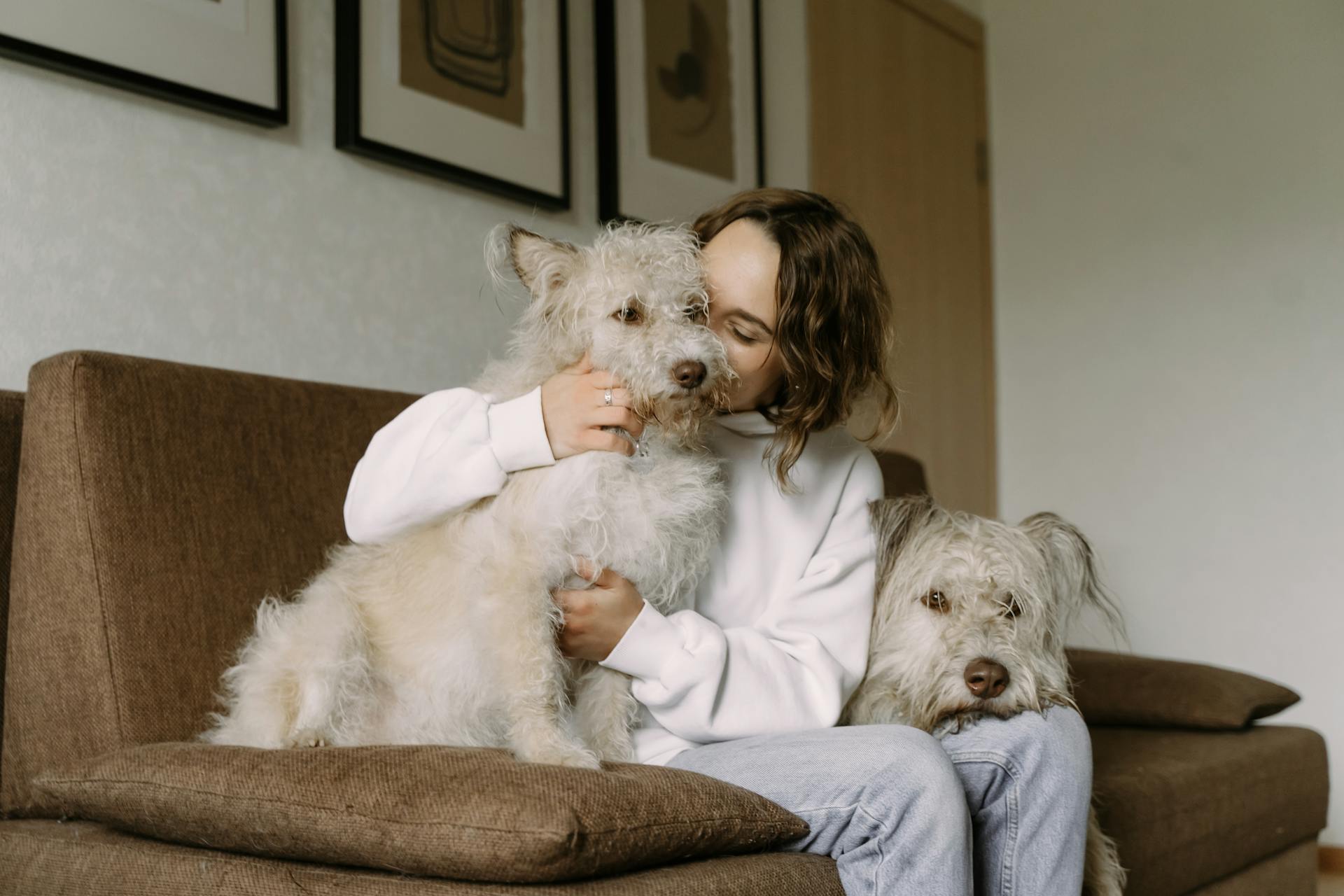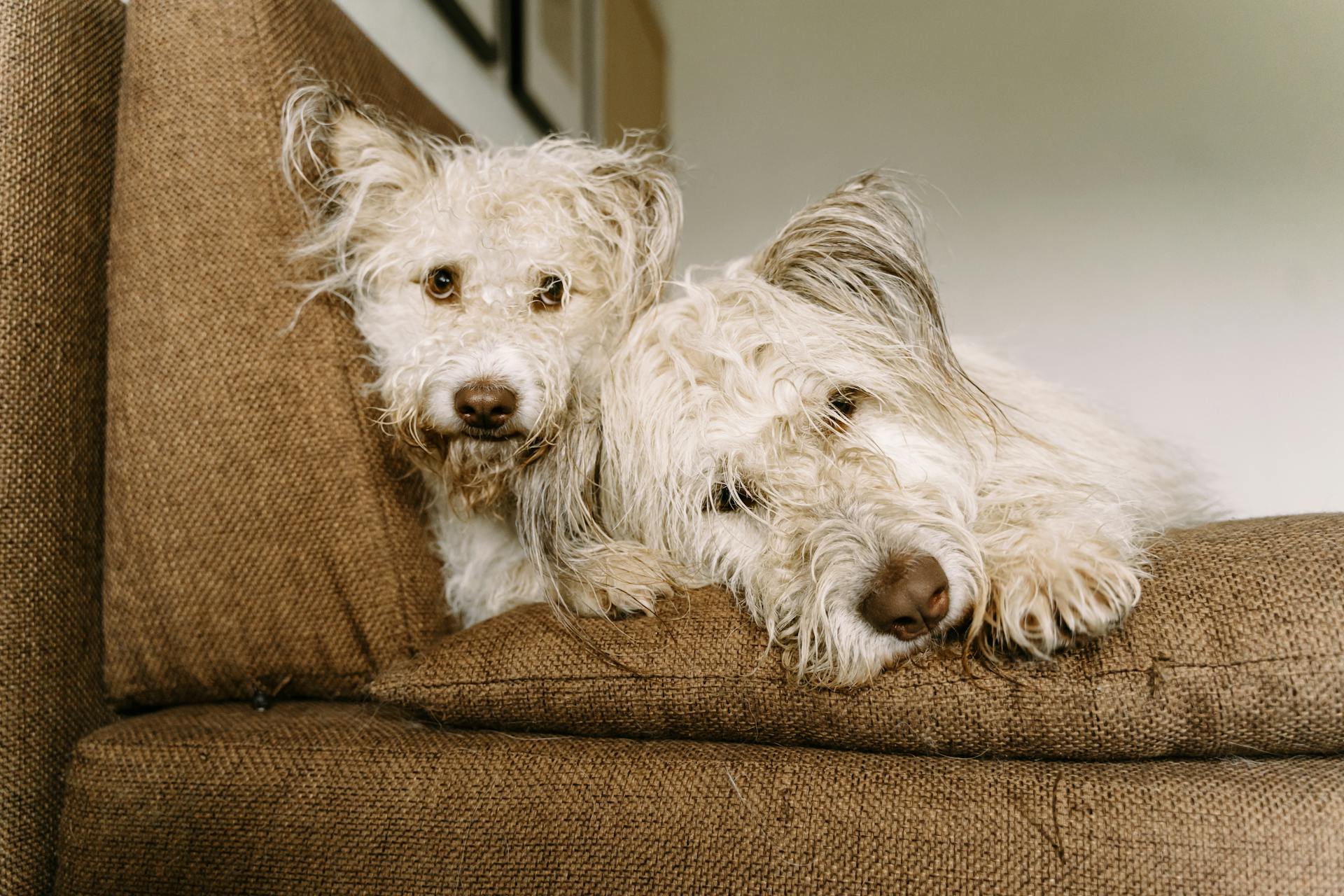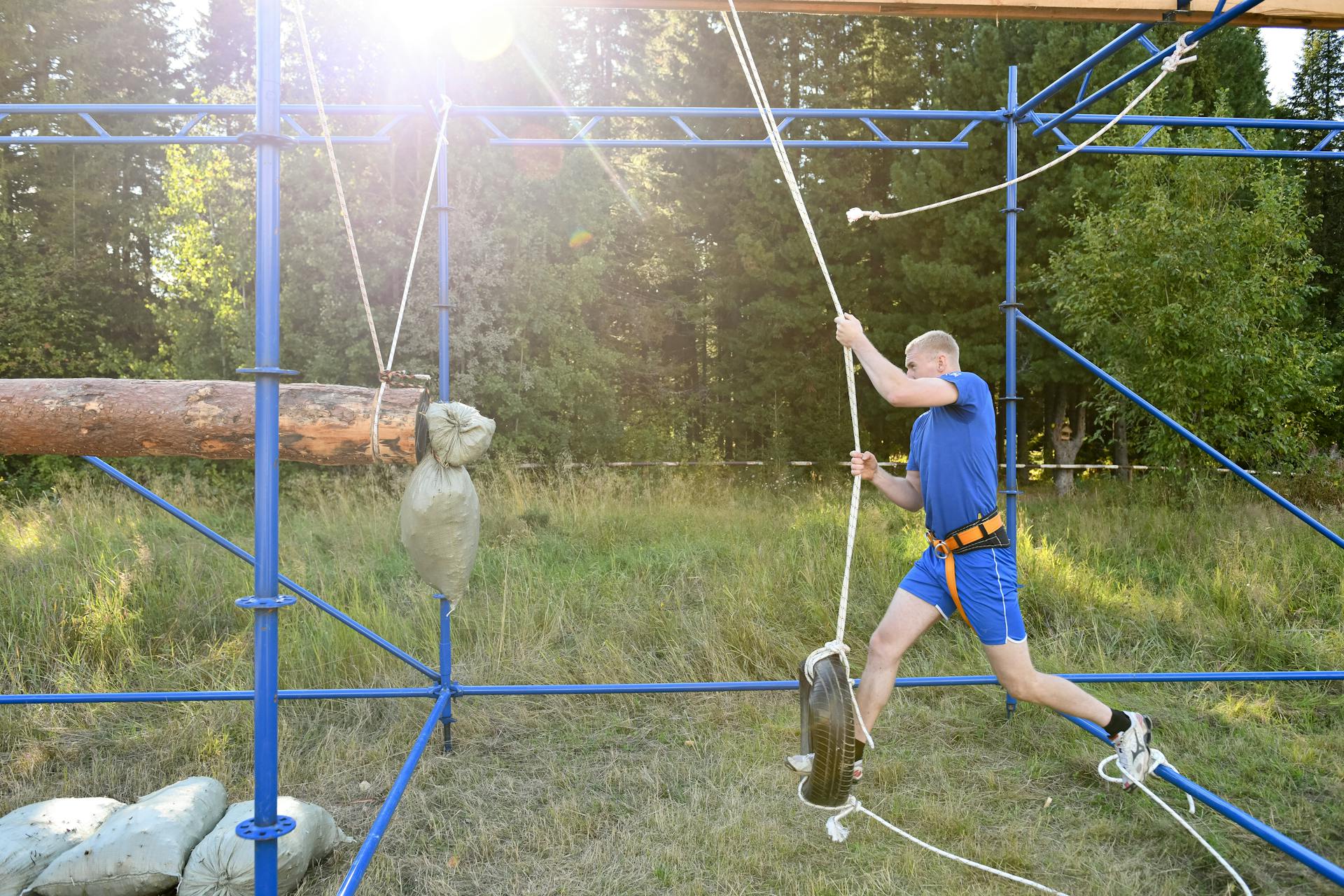
Dogs exhibit anxiety through body language and behavior, and recognizing these signs is crucial for providing them with the support they need.
A raised hackles, often accompanied by a growl or snarl, can be a sign of anxiety in dogs.
Pacing back and forth, often in a repetitive pattern, is a common behavior exhibited by anxious dogs.
Some dogs will also exhibit a tucked tail, which can indicate fear or anxiety.
Dogs may also display excessive panting, yawning, or licking as a way to cope with their anxiety.
Indicators of Stress
Dogs often show stress through their body language, and it's essential to recognize these signs to help them feel more comfortable. A stressed dog may exhibit a "half-moon eye" or show the whites of their eyes, indicating fear or discomfort.
Some common indicators of stress in dogs include yawning, lip licking, and panting, which can be signs of anxiety or stress. These behaviors are often referred to as "fiddle behaviors" by veterinary behaviorists.
Here's an interesting read: How Do Dachshunds Show Affection
A stressed dog may also display avoidance behaviors, such as turning their head away or showing the white part of their eyes. They may even try to escape by focusing on something else, like sniffing the ground or licking their genitals.
Some dogs may pace or shake when they're stressed, which can be a sign of anxiety. This can be seen when they're visiting the veterinarian or in other stressful situations.
A stressed dog's eyes and ears can also give away their emotions. They may have dilated pupils, blink rapidly, or pin their ears back against their head.
Here are some common indicators of stress in dogs:
By recognizing these signs of stress, you can help your dog feel more comfortable and calm.
Handling Stressful Situations
Handling stressful situations with your dog requires you to know his normal behavior. If you're familiar with his regular demeanor, you can quickly tell if he's exhibiting stress signs or just being his usual self.
To differentiate stress signs from normal behavior, look for changes in his body language. If your dog is stressed, his ears may be back or down, his mouth may be tense, and his eyes may be wide or bulging.
You can also check if your dog is exhibiting "fiddle behaviors", which are clear indicators of discomfort. These can include licking his lips when he hasn't eaten or had anything to drink, yawning or having a full body stretch, doing full body shakes when he's not wet, panting when he's not hot, or continual scratching.
Some other signs of stress or fear in dogs include yawning, frequent blinking, lip licking, panting, turning their head away, and showing the white part of their eyes.
If you notice any of these signs, try to remove your dog from the stressful situation and find a quiet place for him to regroup. Resist the urge to overly comfort him, and instead, try to distract him with routine commands like "sit", "down", and "heel." These simple actions can help calm your dog and provide a sense of normalcy.
Here's a quick reference guide to some common stress signs in dogs:
Remember, stress is a normal part of life for both humans and dogs. By being aware of these signs and taking steps to calm your dog, you can help him feel more secure and relaxed.
Anxiety
Anxiety in dogs can manifest in various ways, but one of the most common signs is a tucked tail.
A tucked tail can indicate that a dog is feeling anxious or fearful, as it's a natural defense mechanism to protect the abdomen and vital organs.
Dogs may also display anxiety through panting, pacing, or yawning, which can be a sign that they're feeling overwhelmed.
A dog's anxiety can be triggered by a variety of factors, including loud noises, new environments, or even the presence of other dogs.
Some dogs may become rigid and stiff when they're feeling anxious, while others may become loose and floppy.
An anxious dog may also exhibit avoidance behaviors, such as hiding or escaping from situations that trigger their anxiety.
In extreme cases, anxiety can lead to destructive behaviors, such as chewing or digging, as a way for the dog to cope with their emotions.
Discover more: Grooming a Nervous Dog
Body Language
Dogs exhibit a range of body language to indicate anxiety or stress. A stressed or uncomfortable dog may show calming signals like looking away, turning away, or yawning. They might also perform exaggerated yawns, sneeze, or lick their lips frequently.
A fearful dog will have stiff body language and might hunch over, with their back curved and head close to the ground. Their ears will be tucked back, eyes will show the whites, and their mouth will be tightly closed with the corners pulled back.
Dogs use tail language to communicate their emotions. A tucked under or pointing down tail can indicate fear, appeasement, or stress. On the other hand, a tail carried high, still, or vibrating can suggest assertiveness, confidence, or tension.
Some common calming signals include head turning, half-moon eye, turning away to present their side or back, nose or lip lick, squinting, eye softening, freezing, play bow, yawning, sniffing along the ground, curving, paw lift, shake off, slower movements, sitting or lying down, splitting up, and tail wagging.
Stressed dogs may exhibit fiddle behaviors like licking their lips when they haven't eaten or had anything to drink, yawning or having a full body stretch, doing full body shakes, panting when they're not hot, or continual scratching.
Here are some indicators of stress in dogs:
Dogs may also exhibit appeasement or "submissive" signals, such as avoiding direct eye contact, yawning, nose-licking, lowering their ears, head, and neck, and twisting their neck sideways to look away. They may also hold their tail low or between their legs, wag their tail but stop when touched, or display low crouching, raising a front paw, lying down, or rolling over to expose their abdomen.
Conflict-Related Behaviors
Conflict-related behaviors in dogs arise when they're faced with contradictory motivations, leaving them feeling conflicted and unsure of how to respond.
Dogs may feel conflicted when they perceive a situation as confrontational, such as being near their owner yet fearful of a child on their lap. This internal conflict affects how they respond, and can be shown through characteristic body postures.
These body postures serve as signals to communicate with other dogs, and can be communicated on a graduated scale, with benign, subtle postures usually coming before more aggressive, bold communications.
Aggressive
Aggressive behavior in dogs can be a serious concern, and understanding the signs is crucial to keeping both humans and animals safe.
A dog showing aggressive body language is ready to react to a stressor.
Their ears will often be held differently depending on the reason for the aggression, so it's essential to take a dog's whole body positioning into account.

A fixed, hard stare with wrinkles across the forehead is a common sign of aggression.
Tension around the mouth is another indicator, with wrinkles across the muzzle or a raised upper lip exposing the teeth.
A stiff-legged "ready" stance, with weight shifted forward, is a clear sign of aggression.
The fur might be raised straight up, particularly across the shoulders and at the base of the spine near the tail.
By looking at dog body language as a whole, you can understand what your dog is trying to tell you and act accordingly.
Here are some specific signs of aggressive body language to watch out for:
- Ears: Held differently depending on the reason for the aggression
- Eyes: Fixed, hard stare with wrinkles across the forehead
- Mouth: Tension around the mouth, wrinkles across the muzzle, or a raised upper lip
- Tail: Raised straight up, particularly across the shoulders and at the base of the spine
Conflict-Related Behaviors
Conflict-related behaviors in dogs arise from contradictory motivations, like wanting to be near their owner but fearing a child on their lap. This internal conflict affects how a dog responds and can be shown through characteristic body postures.
Dogs may feel conflicted when they perceive a situation as confrontational or unpredictable, leading to mixed motivations to retreat and remain at the same time. This can result in subtle anxiety or conflict signs.

A dog's body language is communicated on a graduated scale, with benign, subtle postures usually coming before more aggressive, bold communications. However, an individual dog may skip subtle signals or progress through graduated signals rapidly depending on their perception of the situation and past experiences.
Warning signs or threats typically present first, but the ability to read these signs varies between dogs' skill at expressing themselves and humans' attention to these cues.
Consider reading: Signs of Prey Drive in Dogs
Sources
- https://vcahospitals.com/know-your-pet/signs-your-dog-is-stressed-and-how-to-relieve-it
- https://vet.tufts.edu/news-events/news/anxiety-dogs
- https://www.rspcapetinsurance.org.au/pet-care/dog-care/body-language-in-dogs
- https://www.petmd.com/dog/behavior/how-to-read-dog-body-language
- https://vcahospitals.com/know-your-pet/canine-communication---interpreting-dog-language
Featured Images: pexels.com


